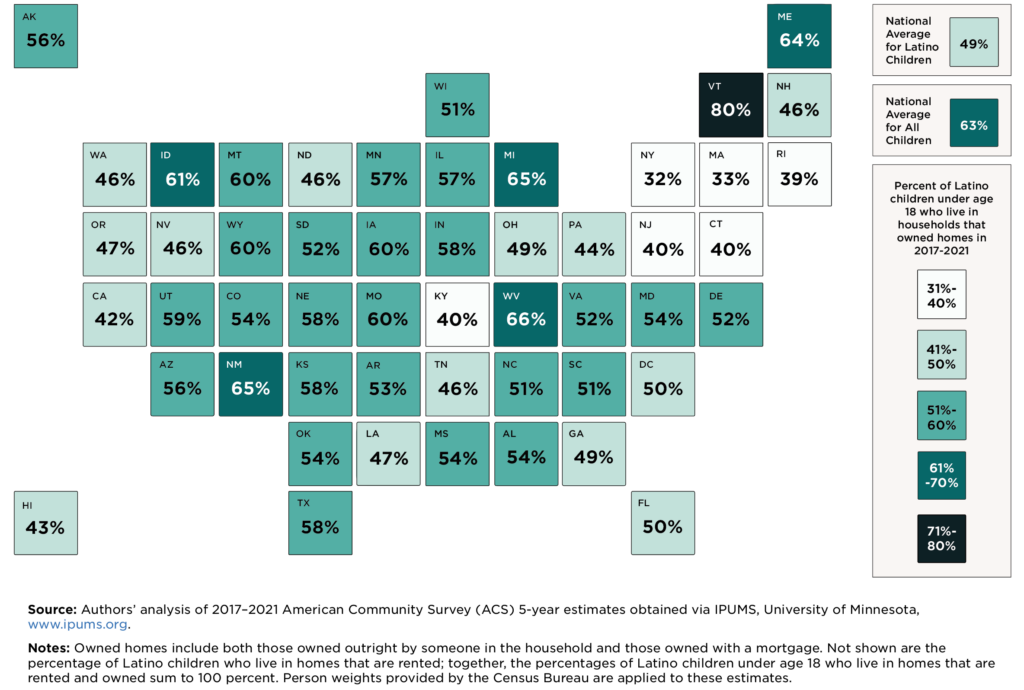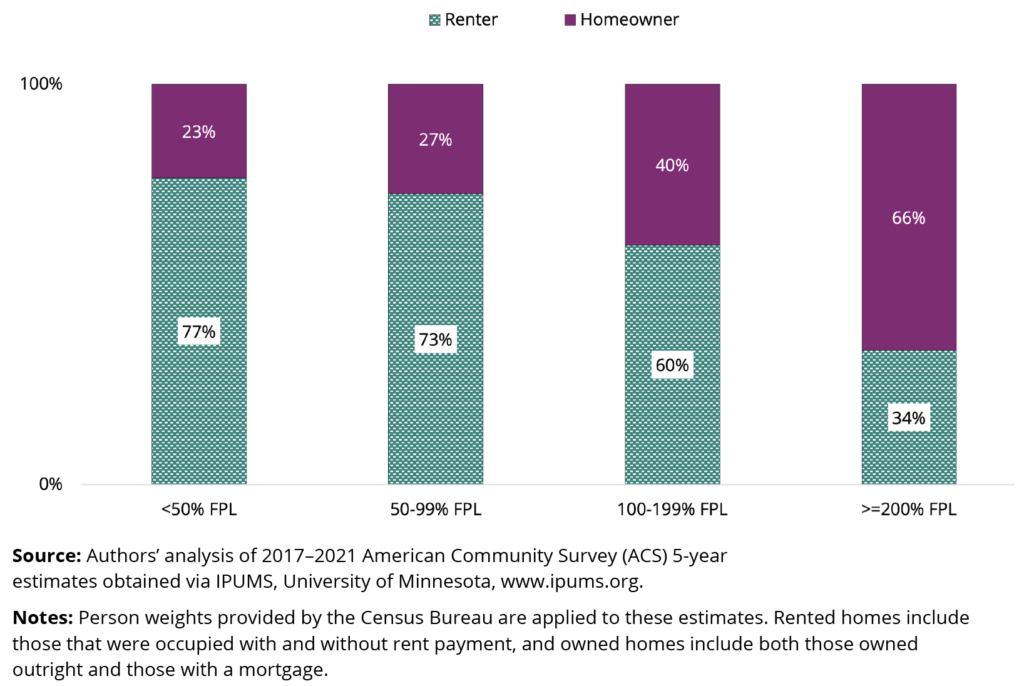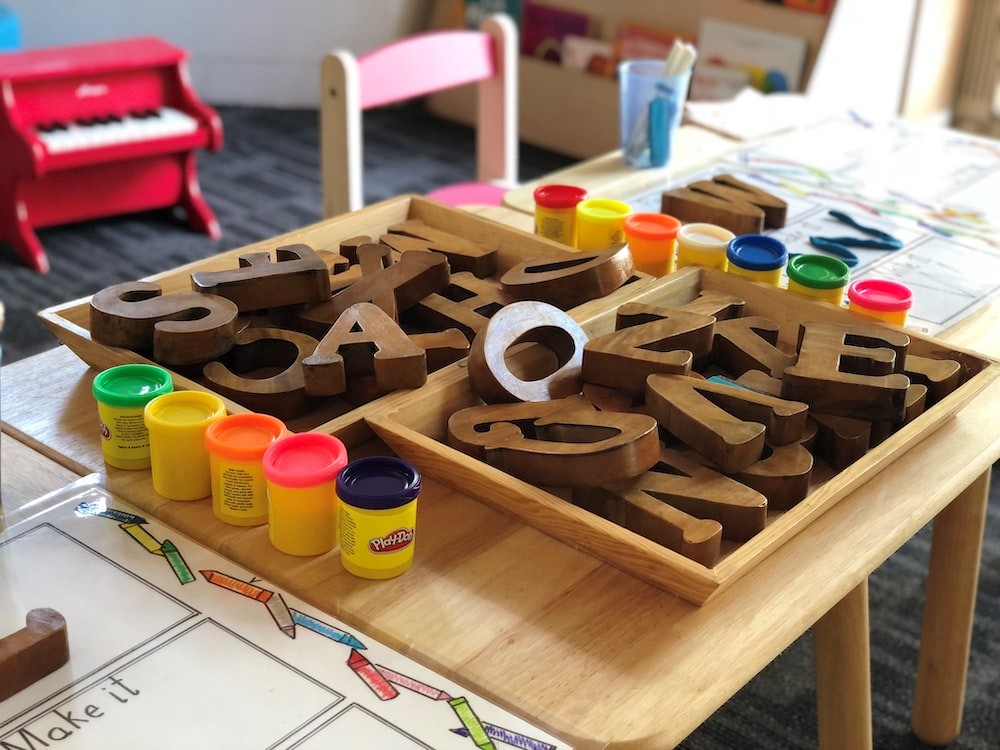Oct 17, 2023
Data Point
Among Latino Children, Nearly Half Live in Households That Own Their Homes
Authors:
Forty-nine percent of Latino children live in housing units that are owned by someone in their household, according to our new analysis of the American Community Survey (ACS) 2017–2021 5-year data.a This includes 36 percent of Latino children who live in households that own homes that carry a mortgage and 13 percent who live in households whose homes are mortgage-free; another 51 percent of Latino children live in rental homes. Overall, 63 percent of all children in the United States live in housing that is owned, which we refer to hereafter as “owned homes.”b Because home ownership is a significant factor in families’ wealth accumulation, we examine the proportions of Latino children living in housing that is owned versus rented. Given the wide variation in home ownership across geographies and income levels, our analysis presents ownership and rental proportions across the 50 states and the District of Columbia and by family income in relation to poverty.
We find a wide geographic variation in the proportion of Latino children who live in homes that are owned by someone in their household. The share of Latino children living in owned homes ranges from a high of 80 percent in Vermont to a low of 32 percent in New York. In 10 states, 60 percent or more of Latino children live in owned homes (in order from highest to lowest): Vermont, West Virginia, Michigan, New Mexico, Maine, Idaho, Iowa, Montana, Missouri, and Wyoming.c Less than 40 percent of Latino children live in owned homes in Rhode Island (39%), Massachusetts (33%), and New York (32%). In total, the percentage of Latino children living in housing units that are owned is above the national average for Latino children (49%) in 34 states.
Figure 1. In 33 states and the District of Columbia, the percentage of Latino Children living in owned homes exceeds the national average for Latino Children
Percent of Latino Children under age of 18 who live in households that owned homes in 2017-2021
Next, we examine the percentage of Latino children who live in owned homes by poverty level of their household. The likelihood of a child living in an owned home generally increases as family income increases. Among Latino children in households below 50 percent of the federal poverty level (FPL), 23 percent live in owned homes and 77 percent live in homes that are rented. Living in rental homes is also more common than living in owned homes among Latino children in households from 50 to 99 percent FPL (73%) and in households from 100 to 199 percent FPL (60%). In total, two thirds (66%) of Latino children in households with incomes below 200 percent FPL live in rental homes. Among Latino children in households with incomes at and above 200 percent FPL, nearly two thirds live in owned homes.
Figure 2. The percentage of Latino children who live in owned homes increases as family income increases
Percentages of Latino children under age 18 who live in homes that are rented and owned in 2017–2021
When we factor income in our analysis of owned versus rental housing, we observe less—but still substantial—geographic variation among children with household incomes below 200 percent of the FPL. Rentals account for close to 80 percent of housing for Latino children living in households with incomes below 200 percent FPL in New York, New Hampshire, Massachusetts, Hawaii, Connecticut, New Jersey, the District of Columbia, Rhode Island, and California. In only three states do more than 50 percent of Latino children in households with incomes below 200 percent of the FPL live in owned homes: Vermont (60%), Michigan (52%), and New Mexico (52%).
Methodology
For this analysis, we used data from the 2017–2021 American Community Survey (ACS) 5-Year estimates. We used the 5-year estimates to have sufficient sample size for our subgroup analyses and to produce the most reliable state-level estimates per ACS guidance.
We define Latino children as children under age 18 for whom a Latino, Hispanic, or Spanish origin was reported, regardless of race. We use “Hispanic” and “Latino” interchangeably. Consistent with the U.S. Census definition, this includes individuals who have origins in Mexico, Puerto Rico, and Cuba, as well as other “Hispanic, Latino or Spanish” origins. There are 643,240 Latino children in the unweighted sample.
To define home ownership, we considered this question from the ACS: “Is this house, apartment, or mobile home—Owned by you or someone in this household with a mortgage loan? Owned by you or someone in this household free and clear (without a mortgage or loan)? Rented? Occupied without payment of rent?” For our analyses, we combined rented and occupied without payment of rent within a single “rented” category and owned free and clear and owned with a mortgage within a singled “owned” category, following IPUMS’ general coding for ownership of housing unit. Less than 2 percent of Latino children lived in homes that were occupied without a rent payment in 2017–2021. Children who lived in group quarters or institutions are excluded from our analyses (0.22% of Latino children; unweighted n = 5,930).
To understand how home ownership is correlated with income levels, we stratified by poverty level. The poverty measure we used is based on the official poverty level and income data available in the ACS (see this summary of the poverty measure in IPUMS). We created variables to indicate four poverty levels for households with incomes below 50 percent of the federal poverty level (FPL), 50 to 99 percent of the FPL, 100 to 199 percent of the FPL, and 200 percent or more of the FPL. Observations without valid income data (mostly missing income data) were excluded from our analyses per ACS’ definition (0.76% of Latino children; unweighted n = 9,655).
Footnotes
a “Owned” housing units include those that are owned free and clear, as well as those acquired with a mortgage or loan, even if repayment was not yet completed.
b We analyze the 2017–2021 American Community Survey 5-year data to ensure that we have sufficient sample size across the geographies examined.
c All lists of states in this resource are ordered by percentage of the state’s housing type for Latino children.
Suggested Citation
McClay, A., Chen, Y., & Guzman, L. (2023). Among Latino children, nearly half live in households that own their homes. National Research Center on Hispanic Children & Families. https://doi.org/10.59377/782n1190g







